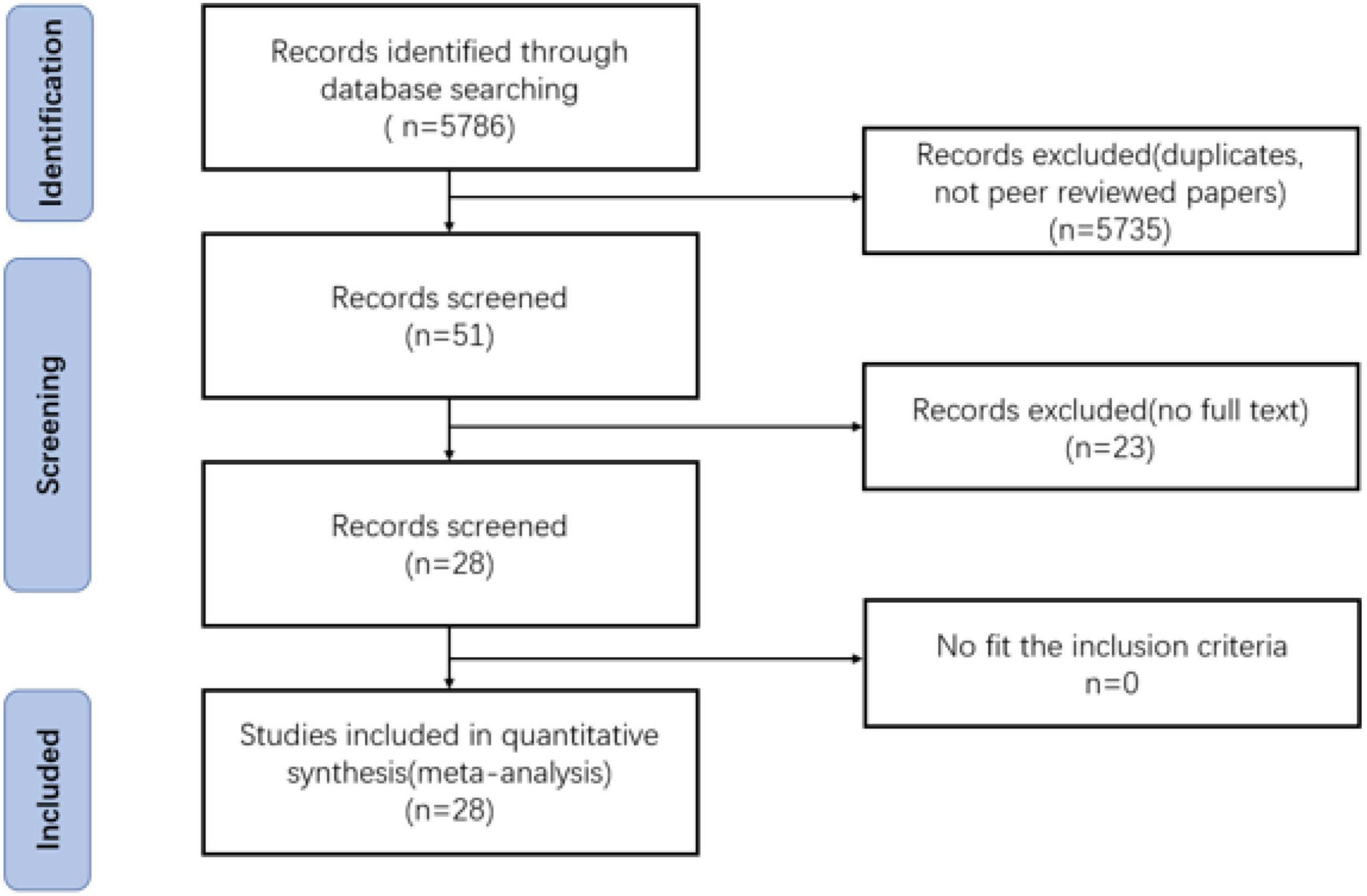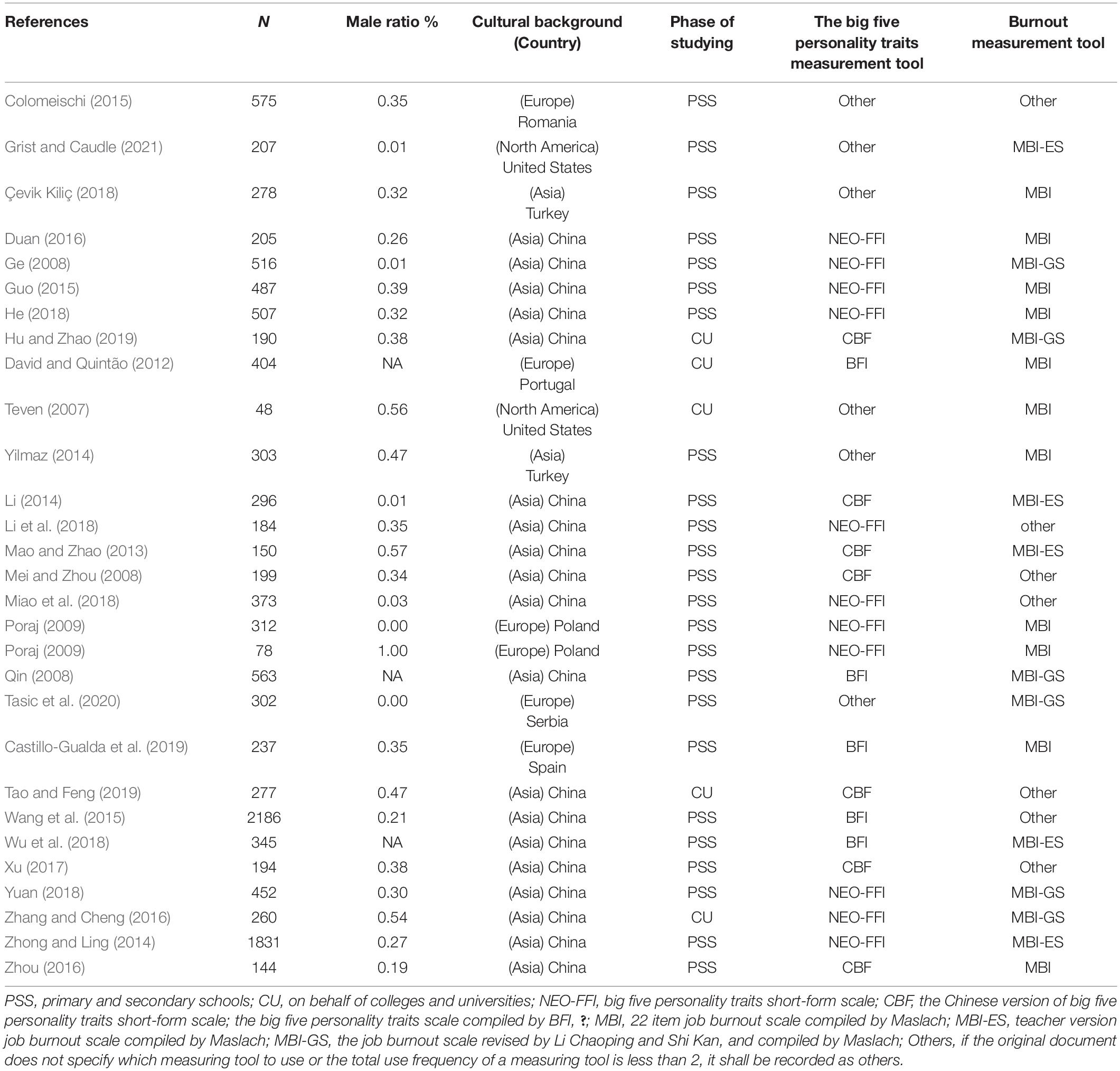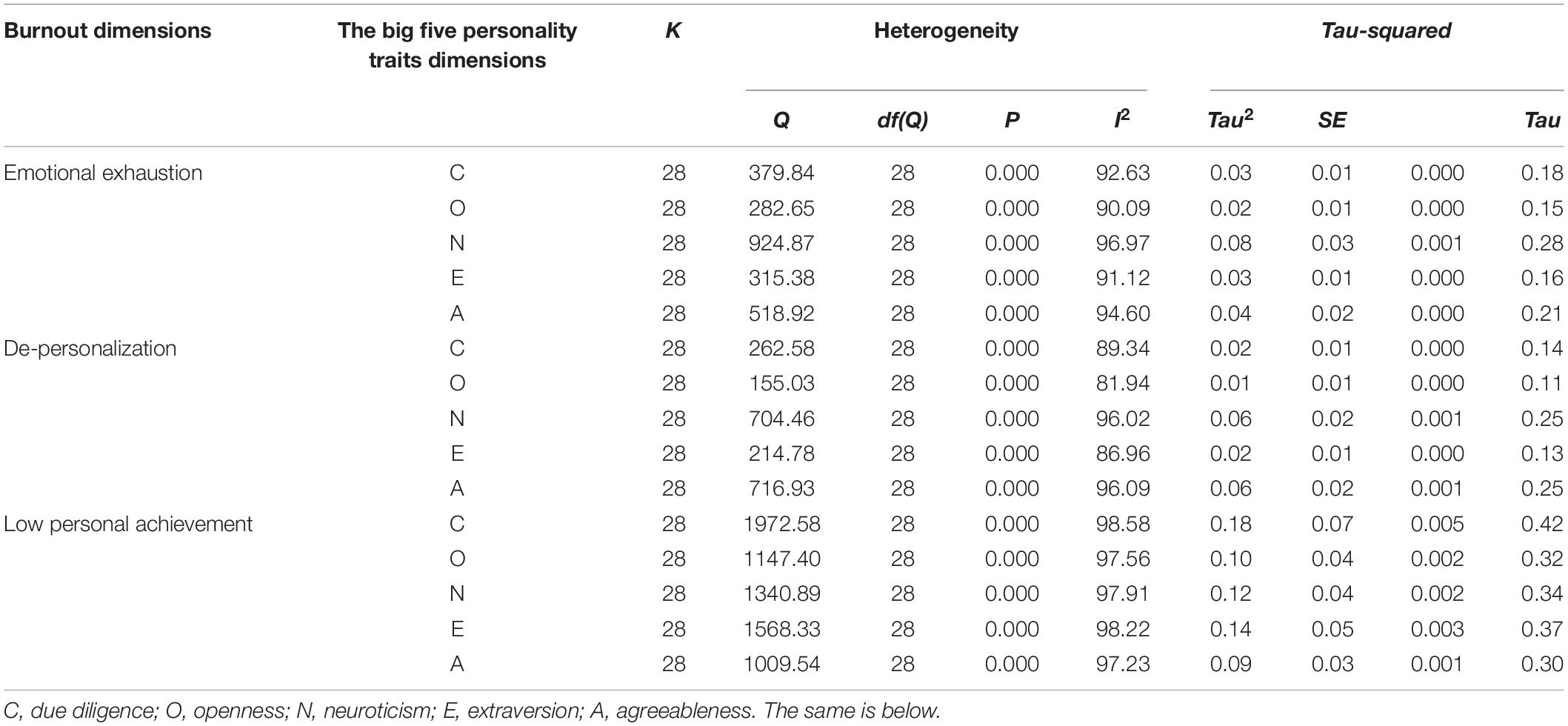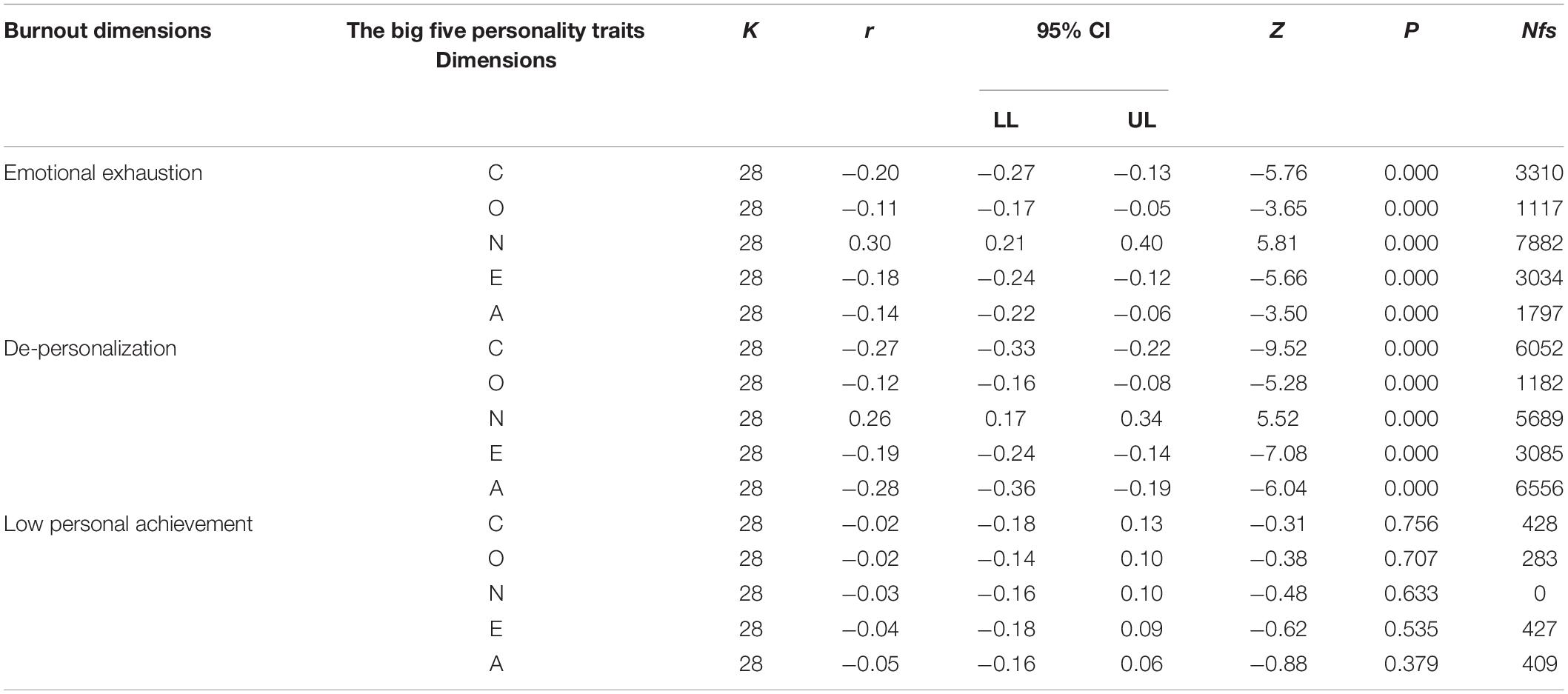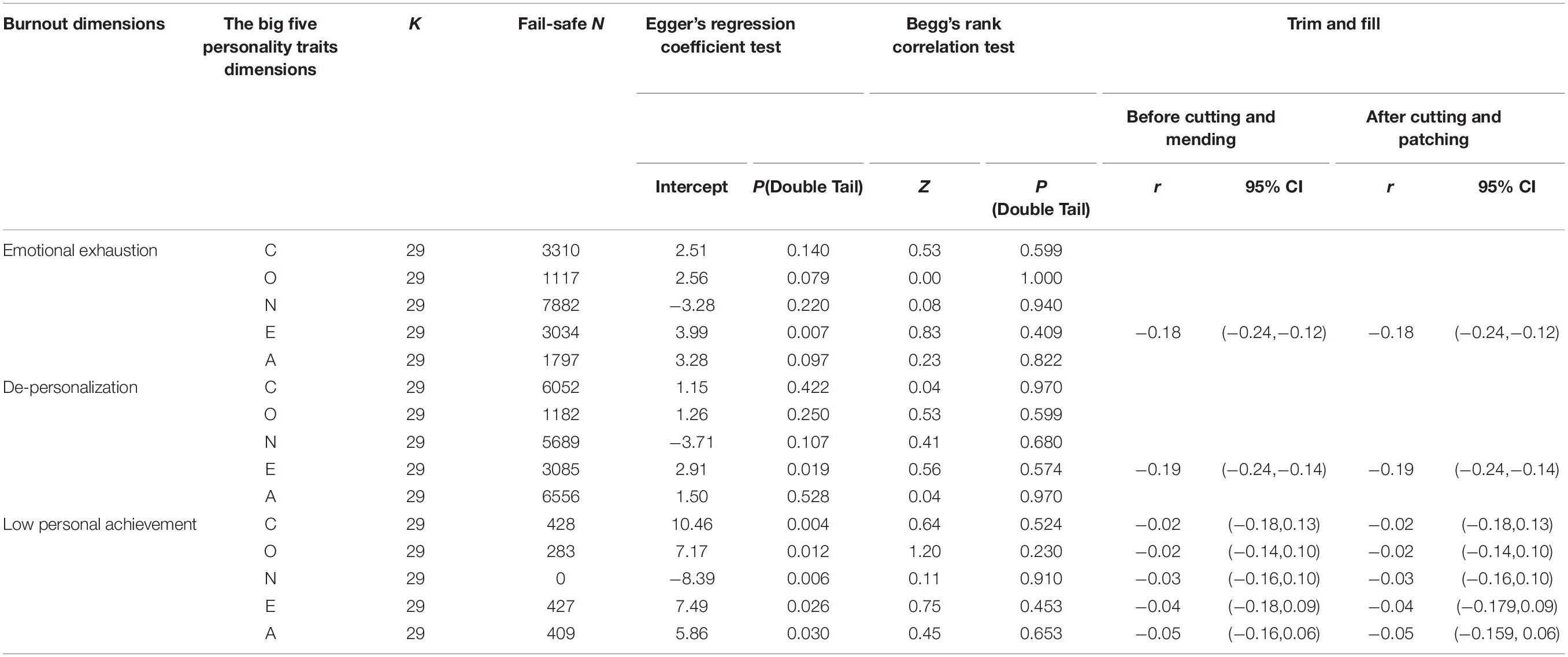- 1School of Educational Science, Gannan Normal University, Ganzhou, China
- 2Department of Student Affairs, Ganzhou Teachers College, Ganzhou, China
Introduction: To explore the relationship between teachers’ job burnout and big five personality traits through meta-analysis.
Methods: Chinese and foreign databases, such as China Knowledge Network Infrastructure (CNKI), VIP Database, Wanfang database, Chinese excellent master’s degree full text, Science Direct, Web of science, Wiley online library, Springer link, Taylor & Francis, and APA PsycNET, were searched, and the relevant literature was collected and screened for meta-analysis.
Results: A total of 28 literatures were included, and the total sample size was 12,103. Meta-analysis showed that the dimensions of emotional exhaustion and depersonalization were moderately negatively correlated with conscientiousness, openness, extroversion, and agreeableness, and the effect values were −0.20 (−0.26 ∼−0.13), −0.11 (−0.17 ∼−0.05), −0.18 (−0.24 ∼−0.12), −0.14 (−0.22 ∼−0.06), −0.27 (−0.33 ∼−0.22), −0.12 (−0.16 ∼−0.08), −0.19 (−0.24 ∼−0.14), and −0.28 (−0.36 ∼−0.19), respectively. The effect values were 0.30 (0.21 ∼ 0.40) and 0.26 (0.17 ∼ 0.34). The dimension of low sense of achievement was negatively correlated with the five dimensions of conscientiousness, openness, neuroticism, extroversion and agreeableness of the big five personality traits, and the influence values were −0.02 (−0.18 ∼ 0.13), −0.02 (−0.14 ∼ 0.10), −0.03 (−0.16 ∼ 0.10), −0.04 (−0.18 ∼ 0.19), −0.05 (−0.16 ∼ 0.06) respectively. The correlation between each dimension of big five personality traits and each dimension of teachers’ job burnout is adjusted by teaching segment, region, big five personality traits scale, and publication age.
Conclusion: The dimensions of emotional exhaustion and depersonalization are negatively correlated with conscientiousness, openness, extroversion, and agreeableness, and positively correlated with neuroticism. The dimension of low personal achievement is negatively correlated with the dimensions of big five personality traits. According to the results of this study, teachers generally have the problem of job burnout, and their personality characteristics have a significant impact on job burnout. School managers should pay attention to this problem and implement necessary interventions. At the same time, the conclusions of this study also provide some guiding significance for teachers’ career development.
Introduction
Job burnout is the exhaustion state of emotion, attitude, and behavior caused by an individual’s inability to effectively deal with various long-term pressures at work. It is composed of three parts: emotional exhaustion, depersonalization, and low personal sense of achievement (Maslach et al., 2001; Zheng and Guo, 2018). Job burnout is regarded as an occupational disease (De Heus and Diekstra, 1999), and is listed in the international classification of diseases by the World Health Organization (WHO). The new version of the classification has come into force in January 2022. It is not only the biggest occupational hazard in the 21st century, but also a hot issue of global concern (Leiter and Maslach, 2005) and one of the common mental health problems among teachers. The teaching profession involves long-term participation in teaching activities and interaction between faculty and staff. During this period, a heavy workload is generated, which could bring emotional discouragement and frustration (Chang, 2020), and this could cause job burnout. The professional work of teachers is arduous and complicated, including a large amount of teacher-student interaction and a lot of education and teaching work. The complicated nature of work creates bad emotions and frustration in teachers, which in turn leads to job burnout. Teachers with job burnout have low job satisfaction and reduced job investment (Akbari and Eghtesadi Roudi, 2020), and also have behaviors, such as turnover intention, absenteeism, and turnover (Swider and Zimmerman, 2010; Rajendran et al., 2020). Teachers’ job burnout not only affects the teachers’ mental health and wellbeing but also affects the classroom atmosphere, students’ wellbeing, and academic performance (Swider and Zimmerman, 2010; Schonert-Reichl et al., 2017). Therefore, the study of teachers’ job burnout and its related factors is very necessary to prevent and intervene in teachers’ job burnout, and protect and improve teachers’ mental health levels.
Previous studies have shown that the causes of teachers’ job burnout arise from three aspects: social system, organizational environment, and individual factors. Although teachers’ job burnout comes from these three aspects, when faced with the same social system and organizational environment, not all teachers will have job burnout. Therefore, under the same system and environment, individual factors are an important reason for the differences in teachers’ job burnout, in which the personality characteristics of individual factors play an important role.
At present, the discussion on the relationship between personality and teachers’ job burnout mostly starts from the big five personality traits. In the recent 10 years, many empirical studies have discussed the relationship between teachers’ job burnout and big five personality traits at home and abroad, but there are still differences among the research results, and it is difficult to draw a more consistent conclusion, mainly in the aspects detailed below.
First, there are great differences in the relationship between teachers’ job burnout and big five personality traits. For example, studies have confirmed that the depersonalization dimension of teachers’ job burnout is significantly positively correlated with the three factors of neuroticism, openness, and extroversion of big five personality traits, and negatively correlated with conscientiousness and agreeableness (Hu and Zhao, 2019). However, some scholars have confirmed that the depersonalization dimension of teachers’ job burnout has a significant negative correlation with the agreeableness, openness, and conscientiousness of the big five personality traits, and a significant positive correlation with neuroticism (Wu et al., 2018). Some foreign scholars have used meta-analysis technology to prove the relationship between teachers’ job burnout and big five personality traits (Kim et al., 2019), but there are some deficiencies in their research. First, they have not discussed the relationship between the three dimensions of teachers’ job burnout and the five factors of big five personality traits, but only discussed the relationship between chief teachers’ job burnout and the five factors of big five personality traits. Second, meta-analysis only covers seven foreign kinds of literature, which are too few and involve other languages. A large number of empirical studies have emerged one after another with the continuous advancement of relevant research, which provides effective materials for exploring the relationship between teachers’ job burnout and big five personality traits.
Second, different researchers have adopted different types of measurement tools for teachers’ job burnout and big five personality traits. For example, for teachers’ job burnout scale, some studies have adopted the job burnout scale prepared by Li Yongxin (Tao and Feng, 2019), while others have adopted the scale prepared by Maslach and Jackson (Bhowmick and Mulla, 2021). In case of the big five personality traits scale, some studies used the scale with 38 items compiled by McCrae and Costa (Teven, 2007), while others used the simplified big five personality traits scale with 60 items (Miao et al., 2018). Therefore, the results of different studies cannot be directly compared, as different measurement tools will affect the nature of the relationship between teachers’ job burnout and big five personality traits, and hence it is difficult to explain the difference between them.
Third, different studies have selected teachers in different educational levels, such as preschool teachers, primary and secondary school teachers, college teachers, and researched different cultural backgrounds. It is worth exploring whether educational levels and cultural backgrounds can affect the relationship between teachers’ job burnout and big five personality traits. Therefore, it is necessary to conduct a meta-analysis on the relationship and regulatory effect between them.
To sum up, the purpose of this study is to comprehensively evaluate the nature of the relationship between teachers’ job burnout and big five personality traits by using meta-analysis technology, and to explore the regulatory variables of the relationship, such as measurement tools, teachers’ gender, teaching period, cultural background, and publication time, to make up for the gap in existing literature and point out the direction for future research.
Materials and Methods
Search Strategy and Study Selection
Through China Knowledge Network Infrastructure (CNKI), VIP Database, Wanfang database, China excellent master’s degree full-text database, and China Doctoral Dissertation Full-text Database, Chinese literature retrieval was carried out under the retrieval conditions of “teacher,” “job burnout,” and “personality.” Foreign language databases, such as Science Direct, Web of science, Wiley online library, Springer link, Taylor & Francis, and APA PsycNET, were used for foreign language literature retrieval with the keywords “teacher,” “job burnout,” and “personality.” The retrieval time was from the time of database establishment to August 2021.
A total of 5,786 kinds of literature were preliminarily retrieved. By reading the title and abstract, 5,735 literature unrelated to the topic, reviewed, and that did not consider teachers as the research object were removed, and 51 relevant kinds of literature were obtained. After reading the full text, 23 kinds of literature that could not calculate the effect quantity and did not report the correlation coefficient were removed, and 28 were finally included, including 19 in Chinese and 9 in English (see Figure 1 for details).
Eligibility Criteria
Inclusion criteria were: ➀ literature research is an empirical study including two variables: teachers’ job burnout and big five personality traits, which are not included in literature review; ➁ in the literature, it is necessary to report the sample size of the research on Teachers’ Job Burnout and big five personality traits, and the correlation coefficient r or T value or F value between them. ➂ the respondents are teachers, including pre-service teachers, preschool teachers, primary and secondary school teachers, and college teachers; and ➃ if the same batch of data is published many times, only one of them is included. If the dissertation is published in journals and magazines at the same time, the journals shall prevail.
Data Extraction
The documents that meet the above inclusion criteria are coded. Each independent sample is coded only once, and the coding contents include: ➀ basic information, such as the first author, publication time, sample size, cultural background, teaching section, publication type (Journal/dissertation), and measurement tools; ➁ the correlation coefficient r between the total score of teachers’ job burnout and the dimensions of big five personality traits; ➂ the correlation coefficient r between the dimensions of teachers’ job burnout (emotional exhaustion, depersonalization, low personal achievement) and the dimensions of big five personality traits; and ➃ gender, each independent sample was coded in the proportion of men.
The document coding process was carried out independently by two researchers. After the coding, the two coding results were compared, and the inconsistencies were discussed and solved jointly.
Statistical Analysis
Excel 2019 was used for coding. Comprehensive meta-analysis software, version 3.0 (CMA 3.0) was used for estimation of overall mean effect value and 95% confidence interval (CI), heterogeneity test, meta-regression analysis, and publication bias test, and the correlation coefficient r was used as the effective value.
Results
Basic Characteristics of Included Literature
A total of 28 pieces of literatures were included in this study, including 19 Chinese literature and 9 English pieces of literature. All were cross-sectional related studies, with a maximum sample size of 2,186, a minimum sample size of 48, and a total sample size of 12,103. See Table 1 for basic information. The r value of the correlation coefficient between each dimension of job burnout and each dimension of the big five personality traits is too numerous and has been transferred to Supplementary Table 1.
Heterogeneity Test
The heterogeneity test was conducted for the relationship between each dimension of the big five personality traits and each dimension of teachers’ job burnout (Table 2). From the results, the Q value was observed to be between 155.03 and 1,972.58 (p < 0.001), and I2 > 75%, indicating that the heterogeneity of effect values is significant, so the random effect model was selected for meta-analysis. At the same time, the heterogeneity of effect value indicates that there may be significant moderating variables in the relationship between each dimension of the big five personality traits and each dimension of teachers’ job burnout, and the moderating effect analysis is also needed.
Main Effect and Publication Bias Test
Table 3 shows the main effect test results of each dimension of the big five personality traits and each dimension of job burnout. It can be seen from Table 3 that the effect values of each dimension of emotional exhaustion, depersonalization, and big five personality traits are medium effects, and 95% CI does not include 0, indicating that the results are relatively stable. The effect value of each dimension of low personal achievement and big five personality traits is a small effect, and 95% CI includes 0, indicating that the result is unstable. At the same time, this study comprehensively uses the loss of safety coefficient, Egger’s regression coefficient test, Begg’s rank correlation test, and shear compensation method to test whether there is publication bias in the literature included in this meta-analysis. The loss of safety coefficient can be used to estimate how much insignificant sample literature is needed to reverse the meta-analysis results. When the loss of safety factor is greater than 5K + 10 (K is the number of documents included), there is no publication bias. On the contrary, the smaller the loss of safety factor, the greater the possibility of publication bias. In addition, when the p-value of Egger’s regression coefficient test or Begg’s rank correlation test is significant (p < 0.05), the publication bias is tested by the pruning method, which affects the meta-analysis results. If the effect value after pruning does not change significantly, it can be considered that there is no publication bias (Xie et al., 2016; Xiang et al., 2017). The results of the loss of safety factor, Egger’s regression coefficient test, and Begg’s rank correlation test in this study are shown in Table 4. It can be seen from Table 4 that the insecurity coefficient of low personal achievement and neuroticism index variables are much less than 5K + 10, and the others are greater than 5K + 10. Secondly, except for the dimensions of emotional exhaustion and extroversion, depersonalization and extroversion, low personal achievement and job burnout, the p values of Egger’s regression coefficient test or Begg’s rank correlation test of other variables were not significant (p > 0.05). In this regard, it is only necessary to test the impact of publication bias on the meta-analysis results of emotional exhaustion and extroversion, depersonalization and extroversion, and low personal achievement and job burnout. The results are shown in Table 4. It can be seen from Table 4 that the effect values of emotional exhaustion and extroversion, depersonalization and extroversion, low personal achievement, and job burnout did not change before and after pruning. Therefore, there is no publication bias in this study.
Regulatory Effect Test
The heterogeneity of effect values indicates that there may be this regulatory variable in the process of the big five personality traits, affecting teachers’ job burnout. Therefore, this study analyzes the regulatory effects of subjects’ teaching segment, publication type, region, big five personality traits measurement tools, job burnout measurement tools, publication age, male proportion, and other factors on the relationship between big five personality traits and teachers’ job burnout, as shown in Tables 5–9.
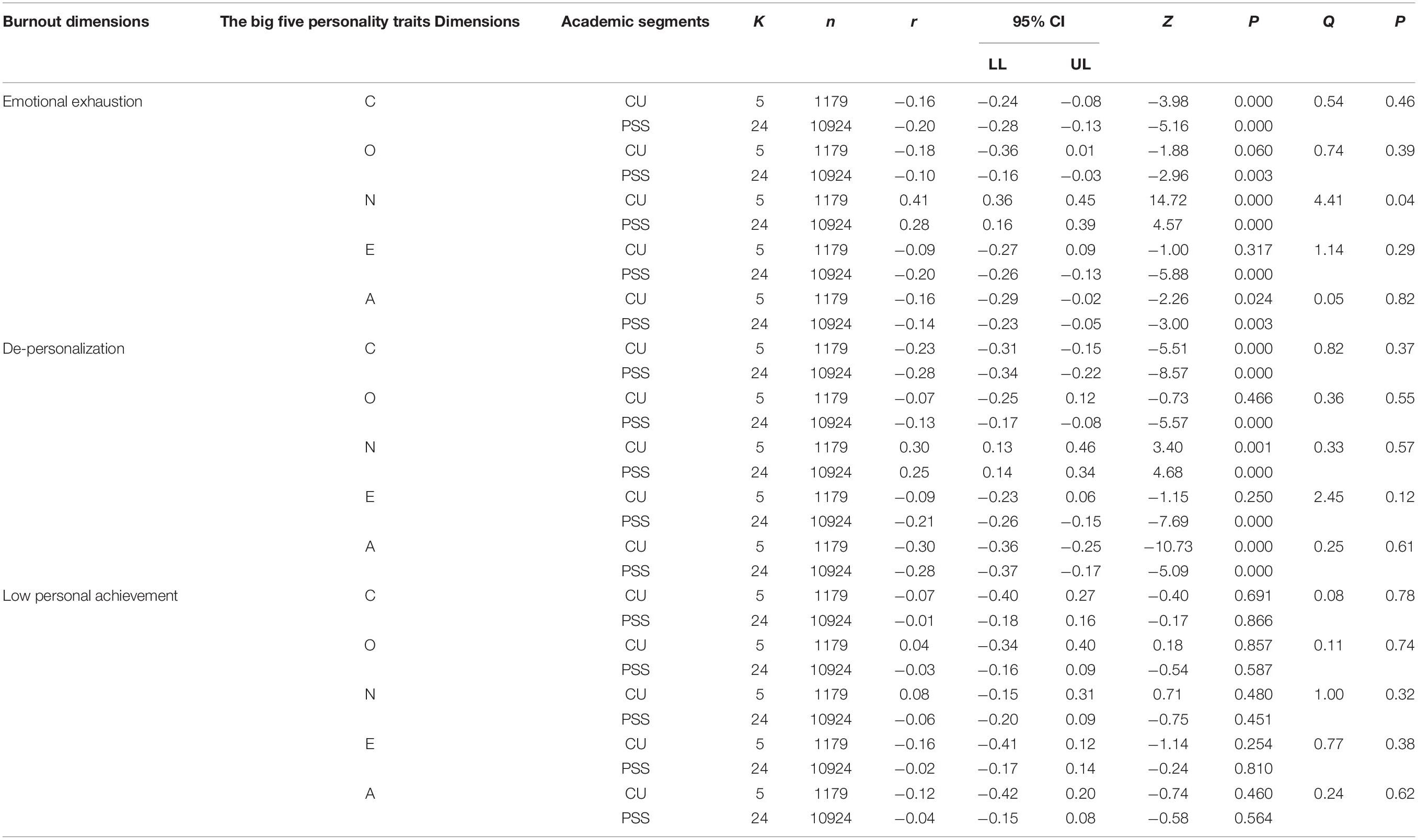
Table 5. Moderating effects of teaching segments on the relationship between big five personality traits and job burnout.
The results of the adjustment effect of the subject teaching section on the big five personality traits and teachers’ job burnout (see Table 5) show that except for the adjustment effect of the subject teaching section on emotional exhaustion and neuroticism being significant (p < 0.05), the others are not significant. Among them, college teachers have a high positive correlation between emotional failure and neuroticism (r > 0.4), and primary and secondary school teachers have a medium positive correlation between emotional failure and neuroticism.
The regulatory effect of region on the relationship between big five personality traits and teachers’ job burnout (see Table 6) shows that there are significant differences in the regulatory effect of region on emotional exhaustion and conscientiousness, neuroticism, and humanity (p < 0.05), while there were no significant differences in the regulatory effect of region on emotional exhaustion and openness and extroversion. Secondly, there were significant differences in the regulatory effects of regions on depersonalization and conscientiousness (p < 0.05), while there were no significant differences in the regulatory effects of regions on personalization and openness, neuroticism, extroversion, and humanity. Finally, there were significant differences in the regulatory effects of the region on low personal achievement, openness, and neuroticism (p < 0.05), while there were no significant differences in low personal achievement, conscientiousness, extroversion, and agreeableness.

Table 6. Regulatory effect of cultural background on the relationship between big five personality traits and job burnout.
The regulatory effects of big five personality traits measurement tools on the relationship between big five personality traits and teachers’ job burnout are shown in Table 7. The regulatory effects of big five personality traits measurement tools on emotional exhaustion, openness, neuroticism, and humanity are not significant. There were significant differences in the regulatory effects of the big five personality traits measurement tools on emotional failure, conscientiousness, and extroversion (p < 0.05). Among them, emotional failure was significantly negatively correlated with conscientiousness and extroversion in different big five personality traits measurement tools. There is no significant difference in the regulatory effects of the big five personality traits on depersonalization, conscientiousness, neuroticism, and humanity. There were significant differences in the regulatory effects of big five personality traits measurement tools on depersonalization, openness, and extroversion (p < 0.05). Depersonalization and openness were positively correlated with the big five personality traits measurement tools of the Chinese version of big five personality traits short-form scale (CBF) type and negatively correlated with the other two types of measurement tools. Depersonalization and extroversion were negatively correlated in different big five personality traits measurement tools. There was no significant difference in the regulatory effects of big five personality traits measurement tools on the dimensions of low personal achievement and big five personality traits.
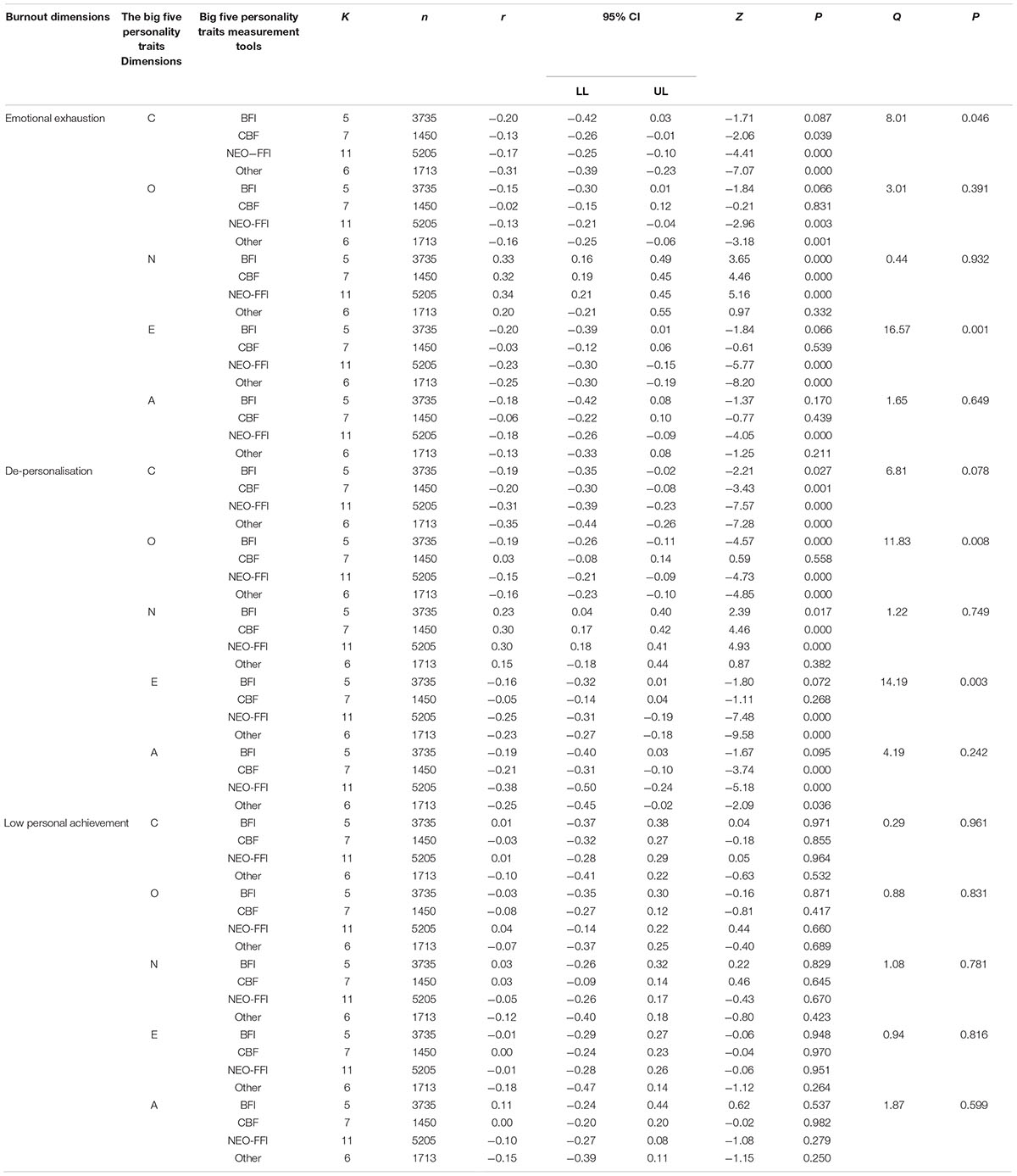
Table 7. Moderating effects of big five personality traits measurement tools on the relationship between big five personality traits and job burnout.
The results of the moderating effects of the measurement tools on the big five personality traits and teachers’ job burnout are shown in Table 8. There is no significant difference in the moderating effects of the measurement tools on each dimension of the big five personality traits and each dimension of teachers’ job burnout.
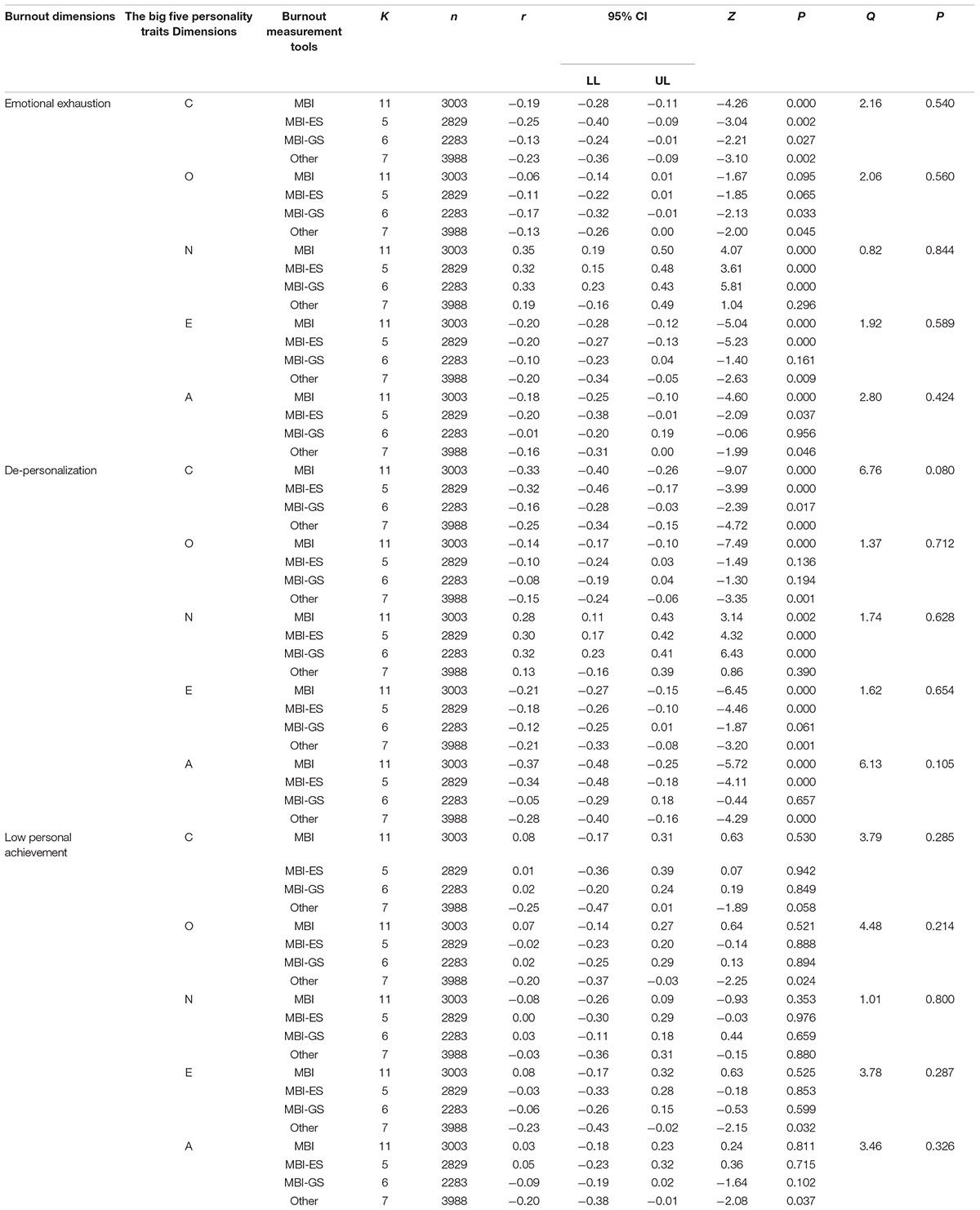
Table 8. Moderating effects of job burnout measurement tools on the relationship between big five personality traits and job burnout.
Meta-Regression Analysis
The publication age and male ratio are taken as independent variables to test whether the relationship between each dimension of big five personality traits and each dimension of teachers’ job burnout is regulated by the publication age and gender (male ratio), and the correlation coefficient between each dimension of big five personality traits and each dimension of teachers’ job burnout is taken as the dependent variable for meta-regression analysis. The results (see Table 9) show that there are significant differences in the regulatory effects of publication age on emotional exhaustion and openness (p < 0.05), and there are also significant differences in the regulatory effects of depersonalization, conscientiousness, and openness (p < 0.05). In addition, there is no significant difference in the regulatory effect of male proportion on the dimensions of big five personality traits and teachers’ job burnout.

Table 9. Meta-regression analysis of the moderating effects of publication age and male proportion on the relationship between each dimension of big five personality traits and each dimension of job burnout.
Discussion
This study conducted a meta-analysis of 28 studies on the relationship between the big five personality traits and teachers’ job burnout at home and abroad. The study found that the dimensions of emotional exhaustion and depersonalization were negatively correlated with conscientiousness, openness, extroversion, and agreeableness, and positively correlated with neuroticism. The dimension of low personal achievement was negatively correlated with the dimensions of the big five personality traits. In relevant studies, there are differences in the relationship between the dimensions of teachers’ job burnout and the dimensions of the big five personality traits (Swider and Zimmerman, 2010; Wang et al., 2015; Miao et al., 2018), but the conclusions of this study support that the dimensions of responsibility, openness, extroversion, and agreeableness in the big five personality traits significantly negatively predict the dimensions of emotional exhaustion and depersonalization. Neuroticism positively predicted emotional exhaustion and depersonalization. Each dimension of the big five personality traits significantly negatively predicted low personal achievement. The results are similar to previous studies (Pishghadam and Sahebjam, 2012). This conclusion shows that teachers with high responsibility are more reliable, have a higher ability to resist pressure, and have higher professional ethics and achievement orientation. High achievement-oriented teachers also have high productivity and will achieve excellent work as the goal, so they will not easily leave their educational work (Zhang and Zhu, 2016). Therefore, teachers with conscientious personalities are responsible for their work till the end, and hence do not easily produce job burnout. Teachers with high openness often have a rich imagination, strong creativity, are curious about things, and devote more energy to their work (David and Quintão, 2012; Göncz et al., 2014; Mousavi, 2017). In addition, teachers with high openness will not easily produce depression and anxiety about the uncertain future but will look forward to future life and be able to perform well in the working environment. Therefore, teachers with high openness do not easily produce job burnout. Teachers with high extroversion can effectively deal with social events and are more likely to have the quality of “advocating morality,” which means doing things first without considering returns (Zhang and Li, 2017). Some studies have also shown that because extroverted individuals have a stronger tendency of sociality or love, such individuals have more popularity and get along well with colleagues (Swietochowski, 2011). Therefore, teachers with high extroversion do not easily produce job burnout. Teachers with high agreeableness often have interpersonal characteristics, such as altruism, forgiveness, compassion, dislike of competition, and not prone to conflict (Cervone and Pervin, 2015), attach importance to the interests of others, and take care of the surrounding students and colleagues. Therefore, teachers with high humanity do not easily produce job burnout. Teachers with high neuroticism can experience more negative emotions, such as psychological pressure and tension, and have poor emotional coping and regulation ability. They also have too many requirements and impulses for themselves and the outside world, so it is not easy for them to study and work hard. At the same time, neurotic teachers have strong self-awareness and pay less attention to their colleagues, resulting in their inability to coexist with the people around them (Onuigbo et al., 2018). In addition, teachers with higher neuroticism set higher work goals for themselves. If they fail to achieve these goals, they develop a sense of loss. In the long run, teachers undergo emotional exhaustion in their work and finally experience job burnout.
The overall conclusion of meta-analysis is not a negation of some unsupported specific studies in reality. Here, only the simple relationship between the two variables is considered, and the closeness of their relationship is likely to be adjusted or disturbed by other variables. Therefore, this study selects variables, such as teaching segment, region, big five personality traits measurement tool, teachers’ job burnout measurement tool, publication age, and male proportion, for regulatory effect analysis.
This study finds that the subject teaching segment plays a regulatory role in the relationship between emotional failure and neuroticism, i.e., the relationship between emotional failure and neuroticism is affected by the subject teaching segment, and this relationship is established no matter which type of subject is taught. The relationship between emotional exhaustion and neurotic personality traits is affected by the types of subjects taught, and the positive correlation between them is the strongest among college teachers, followed by primary and secondary school teachers. The reason for this result may be that when compared with primary and secondary school teachers, most college teachers are employed, sign work contracts for a certain number of years, face a variety of choices after retirement, and have uncertainty about the future. At the same time, in addition to completing teaching tasks, most college teachers also need to complete scientific research tasks, and the workload is more than that of primary and secondary school teachers. Generally speaking, college teachers are under great pressure and face a certain risk of unemployment, which makes teachers with high neuroticism more prone to negative emotions, such as anxiety and tension. At the same time, the increase of self-awareness increases their sense of competition and even behavior with others. Over a long period, teachers’ job satisfaction decreases, resulting in job burnout (Friedman, 2000).
The region is also a moderating variable that affects the relationship between big five personality traits and teacher burnout. First of all, the regulatory effect of region on emotional exhaustion, openness, and extroversion is not significant, which shows that openness, extroversion, and emotional exhaustion are negatively correlated without being affected by region, and the relationship between emotional exhaustion and conscientiousness, neuroticism, and agreeability is affected due to the impact of different regions. Second, the relationship between depersonalization and conscientiousness is affected by different regions, and the relationship between individualization and openness, neuroticism, extroversion, and pleasantness is not affected by different regions. Finally, the relationship between low personal achievement and openness, with its relationship with neuroticism, is affected by different regions, while the relationship between low personal achievement and sense of responsibility, extroversion and agreeableness are not affected by different regions. This result is similar to the research results of Saboori and Pishghadam (2016) on English teachers in Iran. Among them, the negative correlation between conscientiousness, agreeableness, and emotional exhaustion, the negative correlation between conscientiousness and depersonalization, and the positive correlation between neuroticism and emotional exhaustion were the strongest in North America, which could be due to cultural differences and social factors. In the study, the subjects in North America were American teachers, and the subjects in Asia were mostly Chinese teachers. From the perspective of cultural characteristics, the United States and some European countries attach great importance to individualism. The connotation of American individualism includes advocating personal value and personal dignity, advocating people’s all-around development, and encouraging free competition. The goal pursued by the United States is democracy, equality, independence, and the self-centered development of the world. At the same time, American individuals treat people or things based on their interests, i.e., they will give priority to their own needs and happiness. When their self-consciousness is highly independent, they will put their feelings in the first place and will not care about the views of others. However, most of Asia values collectivism, respects the virtue of humility, is more introverted and low-key in personal achievement and performance, considers the interests of others, and values collective consciousness. Therefore, in the context of individualism culture, the impact of teachers’ conscientiousness, neuroticism, and agreeableness on emotional exhaustion and conscientiousness on emotional exhaustion is higher than that of collectivist culture. In addition, from the perspective of social factors, the social status of teachers in the United States is high, and their salary ranks sixth among the thirteen industries in China, which belong to the upper-middle level, while the salary of teachers in China is still relatively low. Second, China is a country with a large population, and the employment situation is severe. Some teachers choose the “teacher” profession as a means of making a living or a career springboard. Relatively speaking, some European and American countries have large population mobility, people are willing to try new things, and their career choices are mostly interest-oriented. Some studies have found that most of the current teachers love this profession very much (Xin, 2015). Therefore, influenced by social factors, the influence of European and American countries on the relationship between openness, neuroticism, and low personal achievement is higher than that of Asian countries. The existing literature rarely discusses the impact of cultural differences on the relationship between big five personality traits and teachers’ job burnout. Relevant cross-cultural studies mostly investigate the meta-analysis of teachers’ emotional intelligence and teachers’ job burnout and also find that there are cultural differences (Zheng and Guo, 2018).
The big five personality traits measurement tool has a moderating effect on the relationship between emotional exhaustion and conscientiousness and extroversion, and it also has a moderating effect on the relationship between depersonalization and openness and extroversion. Among them, emotional exhaustion is significantly negatively correlated with conscientiousness and extraversion in different big five personality traits measurement tools. The relationship between conscientiousness, extraversion, and emotional exhaustion measured by other questionnaire measurement tools is relatively high, indicating that other questionnaires measurement tools have a greater impact on the relationship between conscientiousness, extroversion, and emotional exhaustion. Other questionnaires are mostly questionnaires that only appear once or the author compiles one himself according to the teaching section of the research object. It can be seen that researchers have used targeted measurement tools in different research objects and obtained better measurement results, which also reflects the diversity of the big five personality traits measurement tools from the side. Therefore, the measurement content, dimensions, and cultural applicability of different big five personality traits measurement tools are different, which affects the relationship between teacher burnout and big five personality traits. Future research needs to choose more appropriate measurement tools to explore the internal mechanism between Big Five personality and teachers’ job burnout. The moderating effect of job burnout measurement tools on the relationship between the dimensions of big five personality traits and teachers’ job burnout is not significant, indicating that the correlation between big five personality traits and job burnout is less affected by job burnout measurement tools. Firstly, as far as the job burnout measurement tools Maslach Burnout Inventory (MBI), MBI – Educator Survey (MBI-ES), MBI – General Survey (MBI-GS), and other scales are concerned, although there are differences in the number of questions in the four types of scales, the measurement covers the important components of job burnout, including the three dimensions of emotional exhaustion, depersonalization, and low personal achievement (Ge, 2008; Guo, 2015; Hu and Zhao, 2019), followed by MBI-ES and MBI-GS, the two measurement tools, were compiled and revised based on the MBI scale prepared by Maslach. Therefore, teachers’ job burnout can be measured to a certain extent, and hence it has no significant impact on the relationship between big five personality traits and teachers’ job burnout.
The publication age has a regulatory effect on the relationship between emotional exhaustion and openness, as well as on the relationship between depersonalization and conscientiousness and openness, and the publication age plays a negative regulatory role in the relationship between them. The significant moderating effect of the publication age shows that a growing number of researchers have begun to pay attention to the importance of each dimension of the big five personality traits to each dimension of teachers’ job burnout, which indirectly shows that researchers are paying more attention to teachers’ job burnout, and this in turn promotes the development of the research on the relationship between big five personality traits and teachers’ job burnout. In addition, based on the results of previous studies (Meidani et al., 2019), it is once again verified that teachers should pay attention to reflective teaching with the progress of time, not from the negative perspective of the past, but from the positive perspective. Only in this way can teachers have lower job burnout. Finally, the proportion of men has no moderating effect on the relationship between the dimensions of big five personality traits and teachers’ job burnout. This is similar to the conclusions of previous studies (Zhang et al., 2019). The concept of gender equality holds that his/her role in the field of family and work is determined according to the physiological differences between men and women (Brighouse and Olin Wright, 2008). The higher gender equality view holds that both men and women should actively participate in work and family affairs. The lower view of gender equality holds that work is more important for men while family is more important for women. It can be found that both men and women have their areas of responsibilities, i.e., their careers. They need to spend more time and energy on their careers. Once they get frustrated in this process, it will seriously affect their job satisfaction and lead to job burnout.
Conclusion
The results of this study have certain theoretical and practical significance. The conclusions of this study not only provide theoretical reference for the maintenance of teachers’ mental health and the improvement of teaching quality but also provide practical guiding significance for teachers’ on-the-job training. We can set up special personality education courses as part of on-the-job training, adhere to cognitive education and behavior training in the process of personality education, and help and guide teachers to cultivate stable emotion, conscientiousness, openness, extroversion, agreeableness, and pleasant personality traits.
This study uses meta-analysis to point out the relationship between the dimensions of the big five personality traits and the dimensions of teachers’ job burnout. In the future, we can further explore whether the relationship between the dimensions of big five personality traits and the dimensions of teachers’ job burnout is regulated by other variables. Secondly, this study mainly involves cross-sectional research and cannot make causal inferences. In the future, we should increase longitudinal research to determine the relationship between the dimensions of the big five personality traits and the dimensions of teachers’ job burnout.
Data Availability Statement
The original contributions presented in the study are included in the article/Supplementary Material, further inquiries can be directed to the corresponding author/s.
Author Contributions
ZL and YL conducted data collection, sorting, and analysis. ZL, YL, WZ, and YH participated in the planning and drafting of the manuscript. ZL took the lead in writing the manuscript with the close support of YL and DL. YH participated in the proofreading of the manuscript. All authors participated in the writing of the discussion part of the manuscript.
Funding
This study was funded by the 2020 National Student Innovation and Entrepreneurship Training Program of Gannan Normal University (Grant No. 202010418001), the Ministry of Education Planning Project funded by the National (China) Education Science Planning Unit (Grant No. FHB180568), the Jiangxi Provincial Education Science “Thirteenth Five-Year Plan” 2017 Key Project Fund (Grant No. 17ZD050), and 2020 Postgraduate Innovation Fund of Gannan Normal University (Grant No. YCX20A034).
Conflict of Interest
The authors declare that the research was conducted in the absence of any commercial or financial relationships that could be construed as a potential conflict of interest.
Publisher’s Note
All claims expressed in this article are solely those of the authors and do not necessarily represent those of their affiliated organizations, or those of the publisher, the editors and the reviewers. Any product that may be evaluated in this article, or claim that may be made by its manufacturer, is not guaranteed or endorsed by the publisher.
Supplementary Material
The Supplementary Material for this article can be found online at: https://www.frontiersin.org/articles/10.3389/feduc.2022.822659/full#supplementary-material
References
Akbari, R., and Eghtesadi Roudi, A. (2020). Reasons of burnout: the case of Iranian English language teachers. Psychol. Stud. 65, 157–167. doi: 10.1007/s12646-019-00541-y
Bhowmick, S., and Mulla, Z. (2021). Who gets burnout and when? The role of personality, job control, and organizational identification in predicting burnout among police officers. J. Police Crim. Psychol. 36, 243–255. doi: 10.1007/s11896-020-09407-w
Brighouse, H., and Olin Wright, E. (2008). Strong gender egalitarianism. Polit. Soc. 36, 360–372. doi: 10.1177/0032329208320566
Castillo-Gualda, R., Herrero, M., Rodríguez-Carvajal, R., Brackett, M. A., and Fernández-Berrocal, P. (2019). The role of emotional regulation ability, personality, and burnout among Spanish teachers. Int. J. Stress Manage. 26, 146–158. doi: 10.1037/str0000098
Cervone, D., and Pervin, L. A. (2015). Personality: Theory and Research. Hoboken, NJ: John Wiley & Sons.
Çevik Kiliç, D. B. (2018). The relationship between the burnout levels of music teachers and their personalities. Int. Educ. Stud. 11, 38–54. doi: 10.5539/ies.v11n2p38
Chang, M. L. (2020). Emotion display rules, emotion regulation, and teacher burnout. Front. Educ. 5:90. doi: 10.3389/feduc.2020.00090
Colomeischi, A. A. (2015). Teachers burnout in relation with their emotional intelligence and personality traits. Procedia Soc. Behav. Sci. 180, 1067–1073. doi: 10.1016/j.sbspro.2015.02.207
David, I. C., and Quintão, S. (2012). Burnout in teachers: its relationship with personality, coping strategies and life satisfaction. Acta Med. Port. 25, 145–155.
De Heus, P., and Diekstra, R. F. (1999). “Do teachers burn out more easily? A comparison of teachers with other social professions on work stress and burnout symptoms,” in Understanding and Preventing Teacher Burnout: A Sourcebook of International Research and Practice, eds E. R. Vandenberghe and A. Huberman (Cambridge: Cambridge University Press), 269–284. doi: 10.1017/CBO9780511527784.019
Duan, Y. T. (2016). A Study on the Relationship Between Job Burnout and Personality Characteristics of Teachers in Special Education Schools in Yunnan Province. Doctoral dissertation. Kunming: Yunnan Normal University.
Friedman, I. A. (2000). Burnout in teachers: shattered dreams of impeccable professional performance. J. Clin. Psychol. 56, 595–606. doi: 10.1002/(SICI)1097-4679(200005)56:5<595::AID-JCLP2>3.0.CO;2-Q
Ge, P. (2008). Research on Job Burnout of Kindergarteners—from the Big Five Personality. Doctoral dissertation. Kaifeng: Henan University.
Göncz, A., Göncz, L., and Pekiæ, J. (2014). The influence of students’ personality traits on their perception of a good teacher within the five-factor model of personality. Acta Polytechn. Hung. 11, 65–86. doi: 10.12700/APH.11.03.2014.03.5
Grist, C. L., and Caudle, L. A. (2021). An examination of the relationships between adverse childhood experiences, personality traits, and job-related burnout in early childhood educators. Teach. Teach. Educ. 105:103426. doi: 10.1016/j.tate.2021.103426
Guo, Q. (2015). The relationship among job stress, big-five personality and job burnout of junior middle school teachers. J. Hubei Univ. Educ. 5, 82–86.
He, X. (2018). A Study on the Relationship Between Emotional Regulation, Self-Efficacy, Personality Traits and Job Burnout of Primary and Secondary School Teachers. Doctoral dissertation. Shenzhen: Shenzhen University.
Hu, W. F., and Zhao, H. L. (2019). A study on the influence of five personalities of vocational college teachers on job burnout in Northwest. Qinghai Ethn. Stud. 4, 50–55.
Kim, L. E., Jörg, V., and Klassen, R. M. (2019). A meta-analysis of the effects of teacher personality on teacher effectiveness and burnout. Educ. Psychol. Rev. 31, 163–195. doi: 10.1007/s10648-018-9458-2
Leiter, M. P., and Maslach, C. (2005). Banishing Burnout: Six Strategies for Improving Your Relationship with Work. San Francisco, CA: John Wiley & Sons.
Li, B. B., Xu, Y., and Xi, M. T. (2018). A study on the relationship between personality characteristics and job burnout of secondary vocational teachers. Youth Soc. 32:101.
Li, K. W. (2014). A Research on the Relationship Among Factors of Personality, Burnout and Turnover Intention About the Preschool Teachers. Doctoral dissertation. Haikou: Hunan Normal University.
Loehlin, J. C., Mccrae, R. R., Costa, P. T., and John, O. P. (1998). Heritabilities of common and measure-specific components of the big five personality factors. J. Res. Pers. 32, 431–453. doi: 10.1006/jrpe.1998.2225
Mao, Z. H., and Zhao, C. C. (2013). The relationship between teachers professional burnout and self-efficacy & the regulative effect of personality. Contemp. Teach. Educ. 4, 43–47.
Maslach, C., Schaufeli, W. B., and Leiter, M. P. (2001). Job burnout. Annu. Rev. Psychol. 52, 397–422. doi: 10.1146/annurev.psych.52.1.397
Mei, Y. Q., and Zhou, Y. (2008). A study on the correlation between job burnout and personality traits of primary and secondary school teachers. Adult High. Educ. 2, 34–38.
Meidani, E. N., Pishghadam, R., and Shakeebaee, G. (2019). The role of time perspectives in language teachers’ burnout. Curr. Psychol. 40, 5145–5155. doi: 10.1007/s12144-019-00456-x
Miao, P. J., Xie, S. S., Chen, Z. F., and Lian, R. (2018). The relationship between psychological resilience and job burnout in preschool teachers: testing the mediating roles of big five personality. Stud. Psychol. Behav. 16, 512–517.
Mousavi, R. (2017). Relationship between Big Five personality factors neuroticism, extraversion, agreeableness, openness, loyalty and marital adjustment. NeuroQuantology 15, 63–68. doi: 10.14704/nq.2017.15.4.1154
Onuigbo, L. N., Eseadi, C., Ugwoke, S. C., Nwobi, A. U., Anyanwu, J. I., Okeke, F. C., et al. (2018). Effect of rational emotive behavior therapy on stress management and irrational beliefs of special education teachers in Nigerian elementary schools. Medicine 97:e12191. doi: 10.1097/MD.0000000000012191
Pishghadam, R., and Sahebjam, S. (2012). Personality and emotional intelligence in teacher burnout. Span. J. Psychol. 15, 227–236. doi: 10.5209/rev_SJOP.2012.v15.n1.37314
Poraj, G. (2009). Osobowość jako predyktor zawodowego wypalania siê nauczycieli. Med. Pr. 60, 273–282.
Qin, Y. (2008). A correlation research between job burnout and Big Five personality of preschool teacher. Early Child. Educ. 5, 34–37.
Rajendran, N., Watt, H. M., and Richardson, P. W. (2020). Teacher burnout and turnover intent. Aust. Educ. Res. 47, 477–500. doi: 10.1007/s13384-019-00371-x
Saboori, F., and Pishghadam, R. (2016). English language teachers’ burnout within the cultural dimensions framework. Asia Pac. Educ. Res. 25, 677–687. doi: 10.1007/s40299-016-0297-y
Schonert-Reichl, K. A., Kitil, M. J., and Hanson-Peterson, J. (2017). To Reach the Students, Teach the Teachers: A National Scan of Teacher Preparation and Social and Emotional Learning. A Report Prepared for the Collaborative for Academic, Social, and Emotional Learning (CASEL). Vancouver, BC: University of British Columbia.
Swider, B. W., and Zimmerman, R. D. (2010). Born to burnout: a meta-analytic path model of personality, job burnout, and work outcomes. J. Vocat. Behav. 76, 487–506. doi: 10.1016/j.jvb.2010.01.003
Swietochowski, W. (2011). Professional burnout among university and high school teachers–comparative study. Med. Pr. 62, 133–143.
Tao, J. H., and Feng, Y. (2019). An empirical study on college teachers’ personality traits, organizational identity and job burnout – based on the data of Xi’an colleges and universities. J. Educ. Dev. 11, 27–33.
Tasic, R., Rajovic, N., Pavlovic, V., Djikanovic, B., Masic, S., Velickovic, I., et al. (2020). Nursery teachers in preschool institutions facing burnout: are personality traits attributing to its development? PLoS One 15:e0242562. doi: 10.1371/journal.pone.0242562
Teven, J. J. (2007). Teacher temperament: correlates with teacher caring, burnout, and organizational outcomes. Commun. Educ. 56, 382–400. doi: 10.1080/03634520701361912
Wang, H., Zhou, Y., Wang, K., and Zhou, M. (2015). Personality and job burnout in teachers: cross-level moderating of group identification. Chin. J. Clin. Psychol. 23, 741–745.
Wu, R. H., Gao, M., and Liu, W. F. (2018). The research of specialty faculty’s occupational burnout, job stress, personality traits and the relationships. J. Hainan Radio TV Univ. 2, 145–151.
Xiang, M. Q., Zhang, L. W., Zhang, A. P., and Yang, H. Y. (2017). The influence of ego depletion on sporting performance: a meta-analysis. Adv. Psychol. Sci. 25, 570–585. doi: 10.3724/SP.J.1042.2017.00570
Xie, H. P., Wang, F. X., Zhou, Z. K., and Wu, P. (2016). Cueing effect in multimedia learning: a meta-analysis. Acta Psychol. Sin. 48, 540–555. doi: 10.3724/SP.J.1041.2016.00540
Xin, Z. (2015). Investigation on Job Burnout of Primary and Secondary School Teachers in China. Doctoral dissertation. Qufu: Qufu Normal University.
Xu, J. (2017). An Intervention Study of Reducing Senior High School Teachers’ Career Burnout with Mindfulness Training. Doctoral dissertation. Jinzhou: Bohai University.
Yilmaz, K. (2014). The relationship between the teachers’ personality characteristics and burnout levels. Anthropologist 18, 783–792. doi: 10.1080/09720073.2014.11891610
Yuan, Q. (2018). Relationship Between the JD-R Models and Teacher’s Job Burnout: The Five Personality Mechanisms. Doctoral dissertation. Changsha: Hunan Normal University.
Zhang, J., Zhao, Y., and Zhou, K. J. (2019). A meta-analysis of the relationship between big three personalities and job burnout. J. Neijiang Norm. Univ. 2, 22–30+42.
Zhang, Q. F., and Cheng, G. Z. (2016). Relationship between burnout with mental health and personality traits among physical education teachers of colleges. Sichuan Sports Sci. 6, 64–66+72.
Zhang, R. P., and Li, Q. A. (2017). Personality traits and subjective well-being in Chinese university students: the mediated effect of confucian psychological assets. J. Psychol. Sci. 40, 657–663.
Zhang, Y., and Zhu, Z. Y. (2016). Research on online teachers’ role identity and professional development – a case study of young teachers in China Open University. China Youth Study 5, 74–79+32.
Zheng, C. C., and Guo, L. P. (2018). A meta-analysis of the relationship between teachers’ emotional intelligence and burnout——based on researches in the 21st century. Teach. Educ. Res. 4, 114–121.
Zhong, N., and Ling, H. (2014). Relationship between personality, coping style and job burnout in primary/middle school teachers. Chin. J. Clin. Psychol. 3, 525–529.
Keywords: teacher, big five personality, meta-analysis, moderate effect, personality
Citation: Liu Z, Li Y, Zhu W, He Y and Li D (2022) A Meta-Analysis of Teachers’ Job Burnout and Big Five Personality Traits. Front. Educ. 7:822659. doi: 10.3389/feduc.2022.822659
Received: 26 November 2021; Accepted: 07 February 2022;
Published: 18 March 2022.
Edited by:
Maria Teresa Lluch, University of Barcelona, SpainReviewed by:
Reza Pishghadam, Ferdowsi University of Mashhad, IranZvjezdan Penezić, University of Zadar, Croatia
Margarida Abreu, Duke-NUS Medical School, Singapore
Copyright © 2022 Liu, Li, Zhu, He and Li. This is an open-access article distributed under the terms of the Creative Commons Attribution License (CC BY). The use, distribution or reproduction in other forums is permitted, provided the original author(s) and the copyright owner(s) are credited and that the original publication in this journal is cited, in accordance with accepted academic practice. No use, distribution or reproduction is permitted which does not comply with these terms.
*Correspondence: Ziyan Liu, TFpZMTk5NjA4MjJAb3V0bG9vay5jb20=; Dongbin Li, NDQzMDIxNDkwQHFxLmNvbQ==
 Ziyan Liu
Ziyan Liu Yingnan Li1
Yingnan Li1